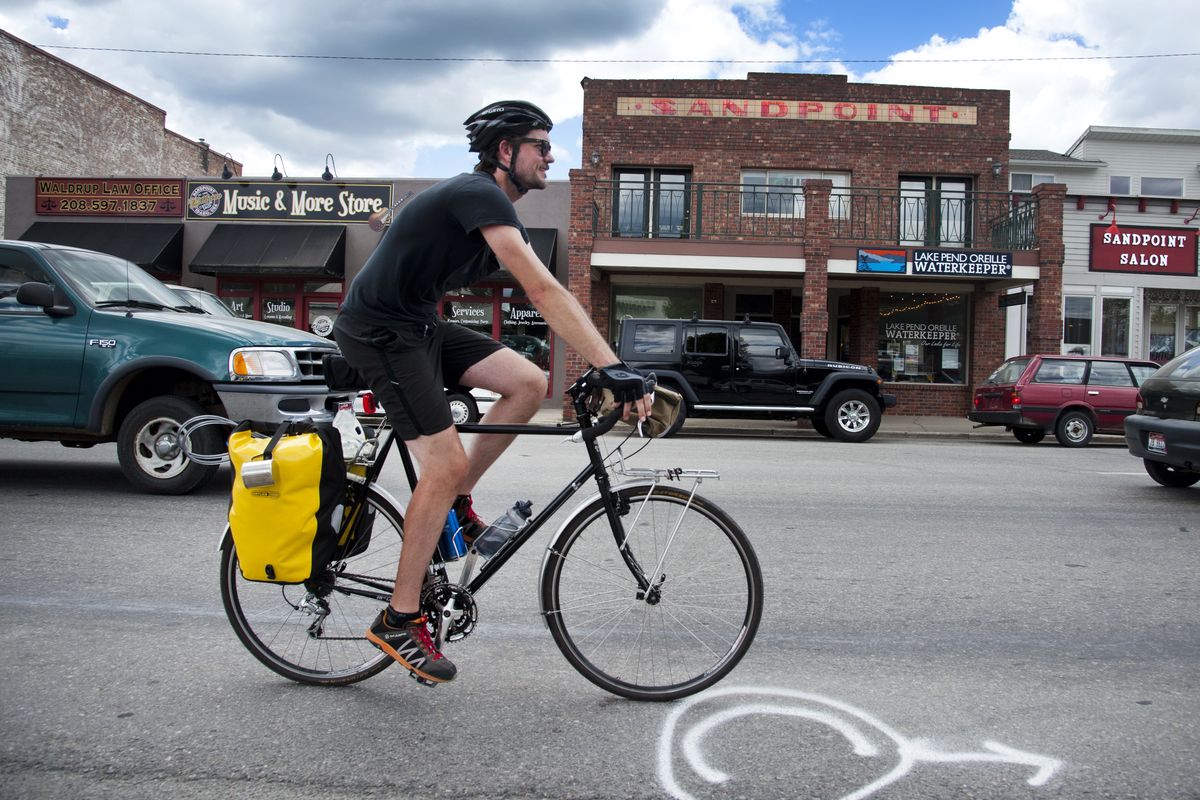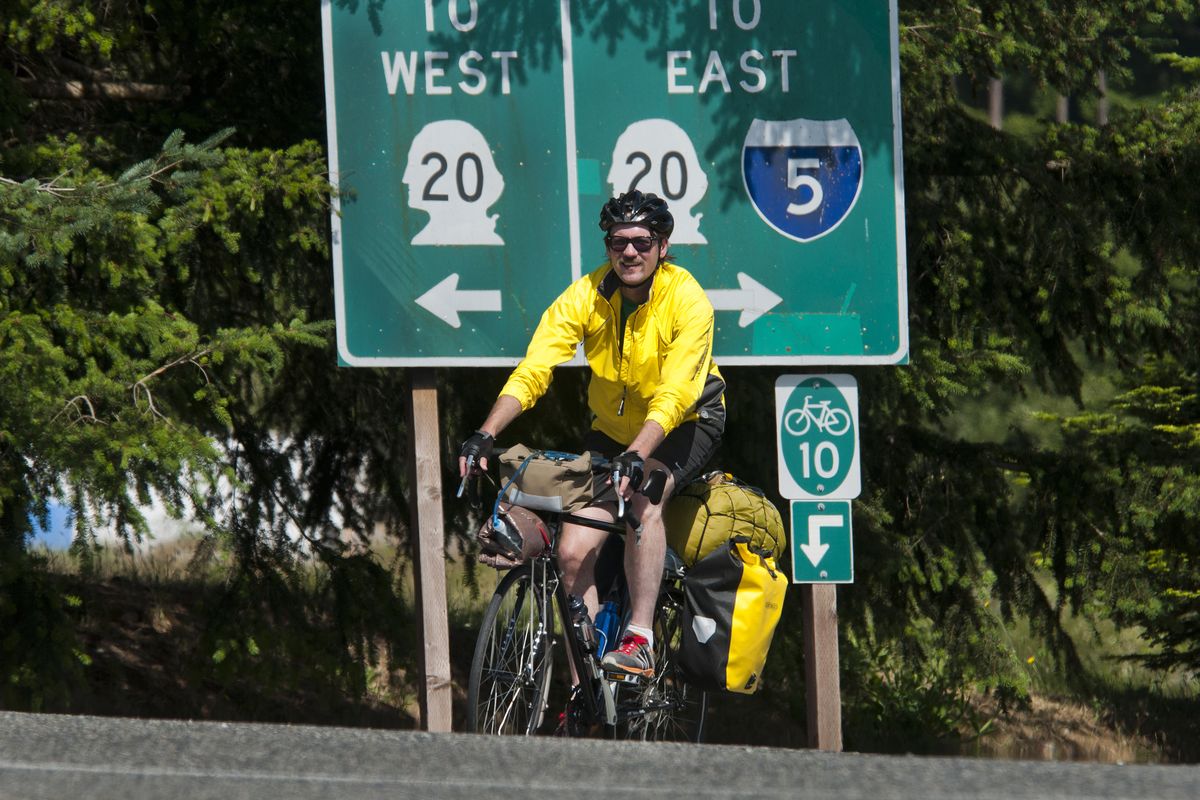Blazing a trail: U.S. Bicycle Route 10 burnishes Washington’s standing as most bike-friendly state in the union
Nick Deshais heads away from Anacortes, Wash., on June 10 as he begins his 482-mile ride on the U.S. Bicycle Route 10 trail towards his destination of Sandpoint. (Dan Pelle)Buy a print of this photo
In a forest of blackened spires, the recent victims of the largest wildfire in Washington’s history, I climbed toward Loup Loup Pass on two wheels, breathing heavy and dripping sweat.
A cardboard box on the side of the road stopped me. It was illustrated with a bicycle ascending the steep incline of Loup Loup, flames licking its tires. “Cold Water,” the box read, describing its contents. “Hot Hot.”
In the days previous, I had ridden from the cool air of Puget Sound into the Skagit Valley. I ascended through the blustery woods of Mt. Baker-Snoqualmie National Forest to the cold alpine reaches of the North Cascades, only to blaze down through the warm winds of Methow Valley.
Already, drivers had affably waved and honked at me. Motorcyclists had given me the low-key salutation usually reserved for their own kind. Strangers approached me on the street to inquire about my journey.
But free water on one of the hardest climbs of my trip? That was a first.
I had seen so much of the state, and been shocked at the hospitality along the way, yet I’d only ridden 175 miles of my trek along U.S. Bicycle Route 10. Many more were between me and my destination of Sandpoint. These miles are a small percentage of those in the national bike highway network.
Washington state’s U.S. Bicycle Route 10 accounts for just 416 miles in the nationwide network of bike routes, which has nearly 9,000 miles of official routes, including Idaho’s recent addition of 66 miles across the Panhandle.
State planners and cycling advocates worked for nearly four years to have the first official Western bike route appear in Washington, and now they say the route will only do more to burnish the state’s standing as the most bike-friendly state in the union.
When the idea of a nationwide network of bike highways was hatched in 1978, the Pacific Northwest was not the cycling mecca it is today. In fact, the first two official routes were designated on the other side of the country in 1982. One stretched from Virginia to North Carolina, and the other connected Illinois, Kentucky and Virginia.
No other routes appeared until 2011, when the dormant U.S. Bicycle Route system was revived by the American Association of State Highway Transportation Officials and Adventure Cycling Association. Since then, the groups have added more than 1,500 miles of bike routes to the system every year. With the recent addition of routes in Idaho and Utah, the USBR network has 8,992 miles in 18 states and Washington, D.C.
As I found on my tour, an official bike route doesn’t require much. No bike lane, signs or even a substantial shoulder is needed, though all of these things are very desirable. The only real rules for an official bike route are it must connect two or more states, or a state and an international border or to another official route.
Of course, nothing is that simple. Every jurisdiction along USBR 10 – 18 cities and towns, seven counties and a handful of transportation districts – had to approve the route. When the work of convincing policy makers and collecting signatures was done, state Transportation Secretary Lynn Peterson had to endorse and sign the application for the route to the American Association of State Highway Transportation Officials, the same organization that approves new highways with a similar process.
“We were engaged from the beginning,” said Barb Chamberlain, executive director of Washington Bikes, a statewide advocacy group. “Our role has been the actual on-the-ground identification of the potential routes and actual routes. That means all along the way, we’ve done local advocacy, working with bike groups if there is one. You need volunteers to do this.”
One of those volunteers is John Pope. He “spearheaded” the effort for the route, rode the whole thing and chronicled his tour for Washington Bikes. His blog posts inspired my trip.
I spoke to Pope early in my trip and he gave me some pointers: watch out for the steep, no-shoulder switchbacks west of Wauconda; enjoy Ione’s red bridge; have fun.
But not everyone can call Pope and get his rundown. That’s why there’s a need for official routes.
Saara Snow, travel initiative coordinator with the Missoula-based Adventure Cycling Association, said at their simplest the routes are way-finding tools for bike travelers. They inform rider to go this way and watch out for that.
Yet the routes, Snow said, are so much more.
“Being a U.S. Bicycle Route helps to show motorists that these roads are being used by a bicyclist, and that brings a new kind of awareness for the roads and their use,” she said. “While we don’t require facilities on every road that is designated a U.S. Bicycle Route, we do hope that when those roads are being maintained, or there’s construction, they’ll add a shoulder or special pathway because bicyclists are using these roads.”
I told Snow there were more than a few stretches along USBR 10 that had no shoulder, where I had to ride in the lane where there was thankfully almost no traffic. She said that’s simply the state of American bike highways. For now.
“That’s just a reality for cyclists on American roads,” she said, noting that increasing bike facilities along the road is her group’s ambition. “That’s definitely a major goal. It’ll take time, but you have to start to somewhere.”
For Washington state, that somewhere is identifying affordable improvements.
Paula Reeves, a planner in the state transportation department’s engineering policy and innovation division, said the state was looking for “quick wins” in an era when funding for transportation infrastructure is limited.
That includes adding bike facilities at international border crossings, as part of Washington and British Columbia’s initiative to reduce greenhouse gas emissions at their border crossings. It includes adding signage to bike routes, and better street striping.
Reeves said the state was identifying places where shoulders could be widened, and perhaps using a different method to resurface roads than chip-seal, which can crowd the shoulder with a jagged, rough surface.
For Reeves, though, it’s less about the pavement improvements than what bicycle traveling and tourism can offer rural communities.
In a chapter titled “A Bicycling Haven” in the recently published book “Planning the Pacific Northwest,” Reeves wrote that for every dollar spent on bike gear and equipment, another $4 is spent on trips and travel.
A recent study – done by Tacoma-based Earth Economics and called “Economic Analysis of Outdoor Recreation in Washington State” – quantified Reeves’ claim, stating that bicycle riding in general generated more than $3.1 billion in annual spending.
Reeves said some rural communities initially had concerns about designating a route, with worries that it would bring requirements about shoulder width and bike lane installation.
Similar concerns were shared by officials in Oklahoma, who blocked the effort by volunteers to designate a route. Despite the ground work being complete, the state transportation department wouldn’t sign off on the effort.
Those worries, in Washington anyway, were easily alleviated.
“There was some initial concern about that, but I think they’re realizing the benefits to their own economies,” Reeves said.
Snow, with Adventure Cycling, echoed Reeves.
“A lot of communities want bicycle tourism in their towns. Bicyclists tend to ride on rural roads, and because of that it brings a new type of tourism these communities don’t normally see,” she said. “Cyclists spend more money than motorized tourists. That’s because they spend more time in the state, they spend more on lodging and food, and they do that in rural communities. Essentially, they have a greater impact on these smaller, rural towns.”
For me on my ride, this was definitely true. A trip that would’ve taken a day in a car took 10 days on a bike. Every 40 to 60 miles, usually after a day of climbing, I pulled into some small town I had previously just driven through, or never been to before. After gorging myself on an inordinate amount of food, I found a campsite or hotel, cash in hand.
That’s the way it should be, said Washington Bike’s Chamberlain.
“It’s not like a race across America. You don’t have to do this as fast as possible,” she said. “Bicycling is the most efficient transportation known to humankind, but you just have to take it a little bit at a time.”


